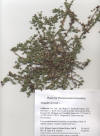|
Anagallis arvensis |
|
Ammar S,, M. A. Mahjoub, N. Charfi, I. SkandaranI, L. Chekir-Ghedira and Z. Mighri. 2007. Mutagenic, antimutagenic and antioxidant activities of a new class of beta-glucoside hydroxyhydroquinone from Anagallis monelli growing in Tunisia. Chem. Pharm. Bull. (Tokyo). 55(3): 385–388. “A new skeleton of an O-heteroside natural substance named zinolol, the first representative of a new class of aminated hydroxyhydroquinone, has been isolated from the whole plant Anagallis monelli. Its structure has been established by one and two dimensional NMR spectroscopic procedures. Antioxidant, mutagenic, antimutagenic activities were realised and positive results were recorded.” Amoros M., B. Fauconnier and R. L. Girre. 1988. Effect of saponins from Anagallis arvensis on experimental herpes simplex keratitis in rabbits. Planta Med. 54(2): 128–131.
Amoros M., B.
Fauconnier and R. L. Girre.
1987. In
vitro antiviral activity of a saponin from Anagallis arvensis,
Primulaceae, against herpes simplex virus and poliovirus. Shehata I. M. and A. F. Nassef. 1956. Pharmacological action of Anagallis arvensis (Ain el Kot). J Egypt Med Assoc. 39(1): 31–35. Shoji N., A. Umeyama, K. Yoshikawa and S. Arihara. Triterpenoid glycosides from Anagallis arvensis. 1994. Phytochemistry 37(5): 1397–1402. “From the herb of Anagallis arvensis, we have isolated four novel oleanane glycosides, anagallosaponins VI-IX, and two artifact saponins, apoanagallosaponins III and IV, formed from anagallosaponins III and IV. The structures were elucidated by chemical and spectral methods, 2D NMR techniques being particularly helpful. The structures of anagallosaponins VI and VII were characterized as priverogenin B 3-O-beta-D-xylopyranosyl (1-->2)-beta-D-glucopyranosyl (1-->4)-alpha-L-arabinopyranoside and 3-O-(beta-D-glucopyranosyl (1-->4)-[beta-D-xylopyranosyl (1-->2)]beta-D-glucopyranosyl (1-->4)-alpha-L-arabinopyranoside), respectively. The structures of anagallosaponins VIII and IX were characterized as 23-hydroxypriverogenin B 22-acetate 3-O-(beta-D-xylopyranosyl (1-->2)-O-beta-D-glucopyranosyl (1-->4)[beta-D-glucopyranosyl (1-->2)]-alpha-L-arabinopyranoside), 3-O-(beta-D-glucopyranosyl (1-->4)-[beta-D-xylopyranosyl (1-->2)]beta-D-glucopyranosyl (1-->4)[beta-D-glucopyranosyl (1-->2)]- alpha-L-arabinopyranoside), respectively. The structures of apoanagallosaponins III and IV were characterized as camelliagenin A 16-acetate 3-O-beta-D-xylopyranosyl (1-->2)-beta-D-glucopyranosyl (1-->4)-alpha-L-arabnopyranoside, 3-O-(beta-D-xylopyranosyl (1-->2)-O-beta-D-glucopyranosyl (1-->4)[beta-D-glucopyranosyl (1-->2)]-alpha-L-arabinopyranoside), respectively.” Shoji N., A. Umeyama, K. Yoshikawa and S. Arihara. 1994. Structures of anagallosaponins I-V and their companion substances from Anagallis arvensis L. Chem. Pharm. Bull. (Tokyo). 42(9): 1750–1755.
Yamada Y., K.
Hagiwara, K. Iguchi, S. Suzuki and H. Y. Hsu. 1978. Isolation and
structures of arvenins from Anagallis arvensis L. (Primulaceae).
New cucurbitacin glucosides.
|
